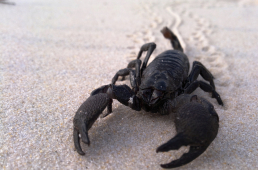
Scorpion Venoms
Scorpion stings and scorpion venoms (or “scorpion toxins”) are almost always the first things that people think about with this arachnid.
But one of the most fascinating things about scorpions is the very broad potential use for their venom. These toxins evolved primarily as a hunting and defense mechanism and have a high degree of potency. Scorpion toxins interfere with the functioning of ionic channels and have specificity, particularly for key signaling molecules in the nervous system. In addition to things like antivenoms against scorpion toxins, there are many potential uses to consider. These toxins contain a range of non-disulfide-bridged peptides that can show antimicrobial, immunomodulatory, hypotensive, and antitumoral activities.
Scorpion stings
It’s important to remember, first and foremost, that scorpion stings are not usually deadly. Young children and older adults tend to be at most risk of complications due to scorpion venoms. According to the Mayo Clinic, out of about 1500 different scorpion species, only about 30 have a venom that is toxic enough to be lethal to humans. But if so few species have such dangerous toxin, why do we devote so many resources to studying them?
Well, lots of people are stung every year. Knowing how scorpion stings differ among species can make a big difference in how to treat these injuries.
Simple toxins
Scorpions are panchronic animals and have a venom that has a very simple composition (at least as far as the Buthidae family, the largest family of scorpions, is concerned). Their venom can be considered as an archetype of primitive venoms. So studying them is of immense value. Goyffon and Tournier, in an editorial for Toxins, note the following:
[The] importance of the venom toxins for developing new drugs must not be underestimated, due to their pharmacological advantages including their high activity, high specificity, lack of accumulation in organisms, low immunogenicity, and limited targets.
As an aside, it isn’t a coincidence that MDPI’s journal Toxins has a scorpion in its logo.
How many scorpion venoms are there?
In short? Lots.
With so many scorpion stings every year (over a million), and over a thousand different species, it’s important for us to learn everything we can. So, how many scorpion toxins are there? Well, it’s a complicated question. Some scorpion venoms can have up to 45 different toxins in them. Each of these toxins might be specifically evolved to affect specific species. For example, one toxin might be better suited to affect mammals, whereas another might be better against insects.
Because scorpion stings are used for both hunting and defense, the utility of a venom to its scorpion may be multifaceted.
Testing the potency of scorpion venoms can be tricky.
Testing the lethality of scorpion venoms
While there are some broad claims about scorpions stings that we accept as true, sometimes it can be difficult to generalize. For example, is scorpion venom lethal? Well, that depends. The deathstalker (Leiurus quinquestriatus), a member of the Buthidae family, is one of the most dangerous scorpions. What makes it particularly dangerous is it’s venom being a mixture of a neurotoxin and the fact that it has a low lethal dose.
But there problem with the way that scorpion venom can affect creatures differently is that it’s difficult to test for lethality.
[The] venom suggests that there may be no feasible universal vertebrate system to test the lethality of different scorpion venoms. Students of the ecological importance of scorpion venom may need to study the effect of venom on each target group separately.
What is scorpion venom good for?
As mentioned before, the utility of scorpion toxins can be far reaching. For example, Mycobacterium massiliense, a fast-growing mycobacteria, can cause a number of issues but has also been shown to cause respiratory tract infections, which are worrisome. ToAP2, a peptide from the venom of the Amazonian black scorpion (Tityus obscurus) has shown in vitro anti mycobacterial activity. Being able to combat these bacteria without using standard existing treatments may help to avoid superbugs.
There has even been research done using scorpion toxins and cancers.
While we might initially think about antivenoms for scorpions stings, the idea of helping in the fight against cancer is also extremely appealing.
Scorpion sizes
Does a scorpion’s size play a role in how dangerous it is? Well, there’s a number of things to think about here.
Pincer size also matters
As we discuss in a previous article:
The size of a scorpion’s pincers is also closely related to the potency of their venom. Species such as the South African Thick-Tailed Scorpion, which has small pincers, have venom that is more than 10 times more potent than, say, the Israeli Gold Scorpion, a species with large and robust pincers.
It makes sense that scorpions with larger pincers can use them for hunting and defense and are less reliant on toxins. In cases where scorpions have smaller pincers, they need more potent venom.
Big scorpion venoms vs. little scorpion venoms
A study, published in Toxins, suggests that scorpion size does matter. As a general rule, larger scorpions tend to have less potent venoms compared to smaller ones. Dr. Kevin Healy and his fellow researchers note that:
“When we look at the most potent, and dangerous, scorpion venoms we find they tend to be associated with species such as the Deathstalker which are relatively small. In contrast, the biggest species such as Rock Scorpions have venoms that are likely to only cause slight pain”
To learn more about scorpion sizes and the potency of venom, we encourage you to read more on the subject in another article from early 2022.
Avoiding scorpion stings
As you can imagine, the answer to this is pretty straightforward. If you’re in an area where scorpions can be found, always shake out clothing and boots before you put them on. Scorpion stings are often a result of the scorpion trying to defend itself. A scorpion might hide in a boot thinking it’s safe, and then sting a foot that threatens to crush it. Wearing long sleeves and pants, leather gloves, or other protective equipment can help if you’re in a place where direct contact might be likely.
The best thing to do if you see a scorpion is to leave it alone.










